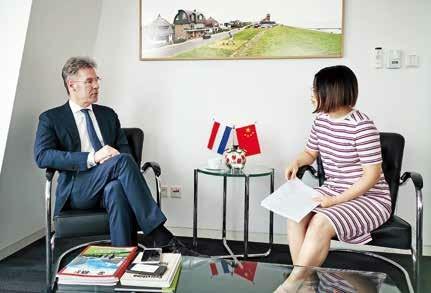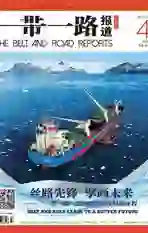“荷兰与中国西部合作空间很大”
2019-09-10李卉嫔
李卉嫔

“Netherlands”在荷兰语中即低地的意思,荷兰约有三分之二的土地基本与海平面同高或者低于海平面。这个填海造陆形成的国家国土面积和人口仅有重庆的一半,却成为了仅次于美国的全球第二大农产品出口国。近年来,随着“一带一路”建设的不断拓展,中荷合作的广度和深度不断提升。农业一直是两国间合作的重要领域,西部地区作为中国农业的重要区域,与荷兰又有哪些合作契机,带着这些问题,记者走进了荷兰驻重庆总领事馆,与荷兰驻重庆總领事孔思哲一同寻找答案。
记者:“一带一路”倡议为中荷两国合作交流带来了哪些新机遇?中欧班列给荷兰与中国西部省市的互联互通带来了哪些新发展?
孔思哲:“一带一路”倡议的提出,尤其是中欧班列开通以来,更加凸显了荷兰作为物流集散中心的突出地位。荷兰靠海临江,有发达的铁路、公路等交通网络,一直是物流大国、国际贸易大国。中欧班列运行以来,除了原有的从上海港通过海运运输货物到荷兰以外,还可以经陆路将来自中国的工业品、荷兰的消费品等更快捷地送达对方的市场,两国都能获得重大发展机遇。作为物流大国,我们可以在优化流程等方面通力合作,让物流更加顺畅高效。
荷兰物流企业十分看好中国西部发展潜力,去年和今年,荷兰连续两年派出物流代表团来重庆考察交流。2018年10月,约40家荷兰物流企业来重庆考察;今年4月,荷兰王国基础设施和水管理部秘书长李德薇女士率荷兰物流代表团一行30人来渝访问,虽然企业数量减少,但政府部门的参与,可以明显看出支持力度的加大。成都-蒂尔堡专线运行3年来,已经从起初的每周两列增开到现在的每周5列;渝新欧物流公司与荷兰物流企业KLG集团已经有多年合作基础,在重庆还设立了办事处,双方致力于共同发展冷链物流;今年4月举行的“武汉·荷兰铁路物流研讨会”上,武汉汉欧物流公司与荷兰阿姆斯特丹港等5家企业签署了备忘录,将共同开发武汉-阿姆斯特丹铁路物流专线,连接武汉和荷兰之间的物流、商业和贸易。渝新欧公司、蓉欧公司在荷兰都设有办事处,可以说,物流业是双方间最具合作前景的产业。
“经贸合作空间很大”
记者:中国西部省市与荷兰近年来的经贸合作取得了哪些实质性进展?
孔思哲:在总领馆的推动下,双方经贸合作有很大空间。作为农业及园艺业强国,荷兰正积极开展与中国西部省市在农业领域的合作,包括出口农产品、推广荷兰先进农业生产技术的应用及分享更高效的农业种植经验。农产品出口方面,目前,荷兰可出口牛肉、鸡肉等食品到中国,还有更多商品贸易协定正在商谈中。农业生产技术方面,荷兰先进的温室种植技术是荷兰成为第二大农产品出口国的重要原因之一,目前这一技术在中国也得到了广泛的应用。瓦格宁根大学是荷兰著名的大学,这所学校农业方面的学科技术含量世界排名第一,有许多中国留学生在此学习先进的农业生产技术。种植经验方面,荷兰的农业合作社模式,充分发挥合作社成员间协作分工精神,大大提高了农业生产效率,即著名的“OVO三位一体”模式(农业科研、教育、推广协同发展,是荷兰农业发展和一体化经营的三大支柱)。重庆、四川、云南、贵州等西部省市有广大的农业区域,充分发挥农业合作组织的协同作用,提高生产效率,是双方合作发展的重大机遇。云南自今年4月纳入总领馆的管辖范围内后,双方企业正合作种植鲜花,并运用温室种植技术提高种植效率。
水资源管理方面,荷兰国情独特,水系发达,是全球著名的“水之国”,擅长管理、利用水资源。中国西部多山区,不临海,但荷兰先进的水管理技术仍然能在这里得到很好的运用。重庆靠近嘉陵江、长江两条河流,需要应用先进的技术管理这些水资源。另外,中国正在推进海绵城市建设,如何更好地蓄留、利用雨水,不使其直接汇入河流、大海,荷兰的技术可在这方面发挥优势。
除此之外,在生命科学、健康养老、创新创业等领域双方也大有可为。随着西部经济的快速发展,娱乐、体育运动等方面市场需求增大,荷兰很多体育企业在考察中表示出投资西部体育运动产业的强烈兴趣。随着中国老龄化的加剧,在老年人照料方面很有优势的荷兰企业已经开始寻找投资机会。长于设计的荷兰,也正在积极寻求与西部省市在创新、设计领域更多的合作。
记者:中国西部企业在荷兰以及荷兰企业在中国西部的投资分别是什么情况?
孔思哲:中国西部企业在荷兰的投资包括设立物流中心、研发中心、销售中心等,充分利用荷兰在欧洲的独特地理优势,高附加值、技术水平高的产业在荷兰有很大的发展潜力。西安诺瓦星云科技股份有限公司,是一家生产显示屏的科技企业,其在荷兰设立办公室的数量越来越多。
荷兰企业投资西部省市的数量随着他们对西部了解的加深逐步增加,除原有的联合利华、壳牌等大型企业,也有一些小微企业进入成都。成都太古里最近有一家销售时髦西服的荷兰企业已正式营业。
总领馆的作用之一是增进荷兰与中国西部对彼此的了解,让他们提起中国,能想到的不再仅有北京、上海等城市,也能多来四川、重庆、云南、贵州等地走走看看。青年人是加强两地交流了解的重要使者,青年富有冒险精神,他们乐于去探索、体验鲜为人知的地方,而西部有趣的文化对他们将产生巨大的吸引力。5月底就有一批荷兰学生来重庆、成都考察交流。
記者:您对中国西部省市有哪些深刻的印象?
孔思哲:我十分喜欢这里的生活,这里的食物,重庆辣子鸡是我的最爱。我现在还会说一些简单的汉语,不用依靠翻译,很多物品的中文名称我都知道。重庆是一个传统文化与现代文明交相辉映、活力四射、气质独特的城市,这里的山、河、桥乃至人民都非常独特有趣;成都是一个比较休闲的城市,我喜欢那里的茶文化,而据我所知,茶文化在西部乃至整个中国都很盛行;西安曾长期作为古代中国的首都,拥有悠久的历史文化;我还希望能去体验云南不同的有趣的文化。总之,西部文化在中国文化中都是独具特色而有趣的。
The word “Netherlands” literally means“low land” in Dutch. In the Netherlands, about two-thirds of the land is nearly at or below sea level. The size and population of the Netherlands, a country that owes a major part of its land to sea reclamation, are both only half that of Chongqing, but it has become the world’s second largest exporter of agricultural products behind the United States. In recent years, the continuous expansion of the Belt and Road Initiative has contributed to constant enhancement of Sino-Dutch cooperation in breadth and depth. Agriculture has always been a major field of cooperation between the two countries. As western China constitutes an important region of agriculture, what kind of opportunities may be brought by cooperation between the Netherlands and the western region of China? With such questions in mind, the journalist interviewed Consul Koen Sizoo at the Consulate General of the Kingdom of the Netherlands in Chongqing to jointly seek for the answer.
Journalist: What new opportunities have been created by the Belt and Road Initiative for the cooperation and exchange between China and the Netherlands? And what new developments has the CHINA RAILWAY Express (CR Express) spurred in the interconnection between the Netherlands and the western provinces and cities of China?
Koen Sizoo: Since the proposal of the Belt and Road Initiative, especially since the CR Express was put into operation, the prominent position of the Netherlands as an international logistics hub has been even more highlighted. Richly endowed by nature with abundant rivers, the costal country, also supported by highlydeveloped transportation networks of railways and highways, is always a major country of international logistics and trade in the world. Ever since the CR Express was put into operation, in addition to the original sea transport of goods from the Port of Shanghai to the Netherlands, it is now also possible to connect China through land transport. In this way, the consumer goods from the Netherlands and the industrial goods from China can be delivered to each other’s market more quickly and conveniently, and both countries can benefit from significant development opportunities therefrom brought by. As major logistics countries, we can act with unified strength in optimizing the procedures to secure smoother and more efficient transport.

Dutch logistics companies think highly of the development potential of western China. In 2018 and 2019, the Netherlands has sent logistics delegations to Chongqing for study and exchange for two consecutive years. In October 2018, about 40 Dutch logistics companies visited Chongqing for study; in April 2019, Mrs. Lidewijde Ongering, Secretary General of the Ministry of Infrastructure and Water Management of the Kingdom of the Netherlands, led a Dutch logistics delegation of 30 members to Chongqing. Although the number of enterprises in the delegation decreased, the involvement of Dutch government clearly demonstrates the increasing support for such visit to China. The Chengdu-Tilburg line has been in operation for three years, witnessing the frequency being raised from two trains per week initially to five trains per week at present; Yuxinou (Chongqing) Logistics Co., Ltd. and the Dutch logistics company KLG Group have been cooperative partners for many years, and KLG has established an office in Chongqing. The two companies are committed to joining forces to develop cold chain logistics; at the “Wuhan-Netherlands Railway Logistics Seminar” held in April this year, Wuhan Asia-Europe Logistics Company signed memorandums with five Dutch logistics companies including the Port of Amsterdam to jointly develop the Wuhan-Amsterdam dedicated railway logistics line, and to connect the logistics, commerce and trade between Wuhan and the Netherlands. Both Yuxinou(Chongqing) Logistics Co., Ltd. and Chengdu-Europe Supply Chain Group Co., Ltd. have set up their offices in the Netherlands. Therefore, it can be said that the logistics marks the most promising industry for Sino-Dutch cooperation.
Journalist: What substantial progress has been made in the economic and trade cooperation between the western provinces and cities in China and the Netherlands in recent years?
Koen Sizoo: With the promotion by the Consulate General of the Netherlands in Chongqing, there is enormous space for economic and trade cooperation between the two countries. As the world’s agricultural and horticultural power, the Netherlands is actively conducting agricultural cooperation with China’s western provinces and cities, including exporting agricultural products, promoting the application of advanced agricultural technologies of the Netherlands, and sharing its experience in achieving higher-efficiency farming management. In terms of exporting agricultural products, the Netherlands can now export beef and chicken to China, and the trade agreements for more commodities are currently under negotiation. In terms of agricultural production technologies, the Netherlands’advanced greenhouse farming technology features one of the major reasons why the Netherlands has become the world’s second largest exporter of agricultural products. At present, this technology has also been widely used in China. Wageningen University & Research, a famous university in the Netherlands, ranks first worldwide in terms of the scientific quality of its subject in the field of agriculture. Many Chinese students have studied or are currently studying advanced agricultural technologies there. In terms of sharing experience in farming management, the Dutch model of agricultural cooperative has put the principle of task division and collaboration into full play among the members of the cooperatives and greatly improved the efficiency of agricultural production. This famous model is known as the “OVO triad” (agricultural research,education, and popularization are the three pillars of the Netherlands’ development and integrated operations of agriculture). There are vast agricultural and rural areas in Chongqing, Sichuan, Yunnan, Guizhou and other western provinces and cities in China. It is a great opportunity for China and the Netherlands to develop cooperation in improving the production efficiency in these regions by giving full play to the synergy of agricultural cooperative organizations. Since Yunnan was included in the duties of the Consulate General in terms of model promotion in April 2018, Chinese and Dutch businesses have been cooperating in cultivating flower crops and using greenhouse technology to improve the efficiency of flower farming.
In terms of water resource management, the Netherlands features unique national conditions with abundant water resources. It is acclaimed as “water country” worldwide, skilled in managing and utilizing water resources. Although western China is largely mountainous and far from the sea, the advanced water resource management technology of the Netherlands can still be of great use here. Chongqing is situated by the Jialing River and the Yangtze River and it needs advanced technology to manage such water resources. In addition, as China is advancing the construction of “sponge cities”, it can draw on the advantages of Dutch water management technology to better retain and utilize rainwater, so that such water will not flow into rivers and seas directly.
Moreover, there are also many opportunities for Sino-Dutch cooperation in the fields of life sciences, healthcare, elderly care, innovative entrepreneurship and so forth. With the rapid economic development in western China, the market demand for entertainment and sports has also increased. Many Dutch sports companies expressed strong interest in investing in the sports industry in western China during their study tours there. As the aging problem in China intensifies, Dutch enterprises that have great advantages in elderly care have already started to look for investment opportunities in China. The Netherlands, a design power, is also actively seeking more cooperation opportunities with the western provinces and cities of China in the fields of innovation and design.
Journalist: How investment by companies of western China in the Netherlands is like and vice versa?
Koen Sizoo: The investment made by the enterprises of western China in the Netherlands mainly covers setting up logistics centers, R&D centers, and sales centers. Giving full play to the Netherlands’ unique geographical advantage in Europe contributes to the tremendous development potential of high value-added and high-tech industries. A typical example is that a growing number of offices have been established in the Netherlands by Xi’an Novastar Technology Co, Ltd., a LED control system manufacturer.
The number of Dutch companies investing in the western provinces and cities of China has also been increasing gradually as their understanding about China’s western region deepens. In addition to the initial large enterprises such as Unilever and Shell, some small and micro enterprises have also started running their businesses in Chengdu. A Dutch company selling fashion suits recently opened in Sino-Ocean Taikoo Li Chengdu.
One of the functions of the Consulate General is to enhance the Netherlands’understanding about western China and vice versa, so that what occurs to the Dutch people about China will no longer be cities like Beijing and Shanghai only. Western regions in China such as Sichuan, Chongqing, Yunnan and Guizhou might also be their destinations. Young people are important envoys to promote exchanges and communications between the two countries. They are more adventurous, willing to explore and experience littleknown places. And the interesting culture of western China will have a huge attraction for them. At the end of May, a group of Dutch students came to Chongqing and Chengdu for study and exchange.
Journalist: What impresses you the most about the western provinces and cities in China?
Koen Sizoo: I really enjoy the life and the food here. Chongqing Laziji (deep fried chicken with dry chili peppers) is my favorite. I can also speak some simple Chinese now. Even without translation, I can recognize many things in Chinese. Chongqing is a vigorous city with unique characteristics where traditional culture and modern civilization merge with and complement each other perfectly. The mountains, rivers, bridges and even the folks here are unique and interesting; while Chengdu is quite a leisurely city. I like the tea culture there. As far as I know, tea culture is very popular in China’s western regions and even all over China. Xi’an had been the capital of several dynasties in ancient China, and it boasts a time-honored tradition and culture. I also hope to experience the various interesting cultures of Yunnan. In short, the cultures of western China are all unique and fascinating pieces of the Chinese cultural mosaic.
